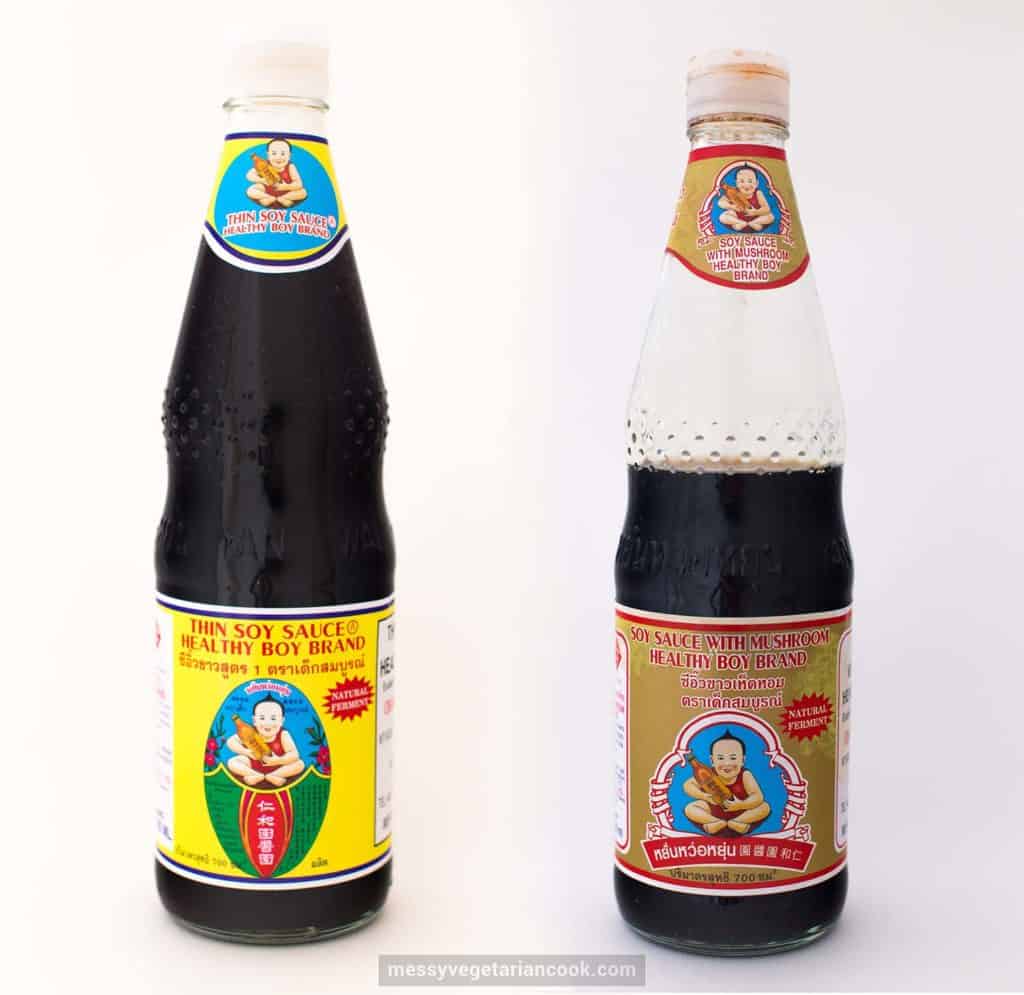Jump to:
Thai cuisine employs a number of sauces and seasonings in food preparation and each plays its own role. The number of different labels and bottles can, however, be mind-boggling, so below is a brief description of the major sauces and their uses. This is not a comprehensive list.
Light soy sauce / thin soy sauce (see ew khao – ซีอิ๊วขาว)

Light soy sauce is also called white soy sauce or thin soy sauce. This is your basic soy sauce, but with a Thai twist. Thai soy sauce has a mild and soft salty flavour not present in many other Asian soy sauces, hence I don't think non-Thai varieties are appropriate for use in Thai recipes (but they work fine, don't worry). My favourite brand is Healthy Boy, which comes in both large and small bottles. If you need to replace fish sauce in a recipe, use thin soy sauce and some salt.
Mushroom light soy sauce (ซีอิ๊วขาวเห็ดหอม) can be used interchangeably with plain light soy sauce. It’s a matter of preference.
Seasoning sauce (sot prung rot – ซอสปรุงรส)
Seasoning sauce is most easily recognised by its green lid. Golden Mountain brand is my favourite, but despite the difference in taste it’s interchangeable with Maggi seasoning (which is commonly found as a condiment in Thailand). Often considered the secret ingredient in Thai cooking, you’ll probably love this stuff so much you’ll need a new bottle before long. When seasoning sauce is called for in a recipe, assume it’s referring to Golden Mountain brand, which is ubiquitous across Thailand. Healthy Boy also makes a good version.
Dark/Black Soy Sauce (see ew dahm – ซีอิ๊วดำ)
Things start to get confusing with dark/black soy sauce since there are many varieties, each with its own subtleties and varying levels of sweetness. I keep two on hand, one sweet bottle and one that contains molasses and is bolder and less sweet. Dark soy sauce is thicker than white or thin soy sauce, with a viscous, syrupy consistency. It is different than Chinese dark soy sauce.
Dark/Black Soy Sauce is sometimes labelled as stir fry seasoning sauce (not to be confused with the seasoning sauce mentioned above), this is a strong and bold, salty and somewhat sweet soy sauce with a strong molasses flavour.
Dark Sweet Soy Sauce (see ew waan – ซีอิ๊วหวาน)
Dark Sweet Soy Sauce is not dissimilar to Indonesian kecap manis. This syrupy sauce is thick, dark, and sweet. This is an essential ingredient in pad see ew and is often used as a dipping sauce.
Fermented soybean paste (Tao Jeow – เต้าเจียว)
Fermented soybean paste is also known as yellow bean sauce and salted soy beans. Tao jeow will heighten the flavour of just about any food. It's available in a slightly more chunky blended form, like pictured, and as split fermented beans in brine. Use in stir fries, rat na, and stir fried morning glory.
Sukiyaki sauce (nam jim suki – น้ำจิ้มสุกี้)
Sukiyaki sauce is served alongside sukiyaki (also called steamboat or hot pot), a communal dish where a pot of simmering broth at the table is used for cooking fresh ingredients such as dumplings and vegetables. Suki sauce was developed to accompany the Thai variation of the steamboat, and is suitable for pretty much vegetable you'd have along with your hot pot. Not a traditional preparation, but I also enjoy it mixed through noodles because it takes four seconds and sometimes I want four second noodles.
Thai sweet chilli sauce (nam jim gai – น้ำจิ้มไก่)
Thai sweet chilli sauce is a versatile condiment that can be used as a dipping sauce or marinade for just about anything. Its name, nam jim gai, translates to chicken dipping sauce as it is served with grilled chicken. This sauce is excellent with grilled foods or deep fried foods like spring rolls.
Sriracha (sot see rah shah – ซอสศรีราชา)
Sriracha, which is not pronounced like see-rah-cha or see-rah-chee (it's see-rah-shah), is available in varying degrees of heat. This bright red garlicky chilli sauce also appears to be one of the most popular non ketchup table condiments in many countries outside of Thailand, but there is a gulf of difference between Thai sriracha and the style of Huy Fung and Flying Goose brands. The difference is Thai versions are a little sweeter, less garlicky, and thinner than those popularly available in North America and European supermarkets. I love both and use them liberally.
For information about vegan fish sauce, please see my post vegan alternatives to fish sauce, shrimp paste, and oyster sauce in Thai cuisine.